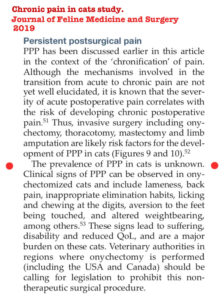January 2021
The American Animal Hospital Association (AAHA) has a 2015 declawing position statement.
AAHA says they are strongly opposed to declawing yet they allow it in their accredited animal hospitals.
Please sign our petition to AAHA. AAHA Petition
Many AAHA Accredited Animal Hospitals declaw cats. Here’s our story about the 2020 AAHA animal hospital of the year winner. AAHA 2020 animal hospital winner
AAHA says in their 2015 declawing position statement that they believe that there is insufficient data regarding behavioral issues after a declaw. AAHA’s 2015 Declawing Position Statement
Let’s educate AAHA about this issue.
Here’s a 2017 study that showed Pain and Adverse behavior in declawed cats. Pain and Adverse behavior in declawed cats study
A 2017 study showed that declawed cats have higher levels of cortisol in their bodies than cats with their toes and claws. Higher levels of cortisol is an indication of chronic stress. Chronic stress causes behavioral issues. Here’s our story about this. Declawed cats have chronic stress
Here’s a 2019 study that shows that declawing causes chronic pain.  Declawing causes chronic pain
Declawing causes chronic pain
Here’s a list of more studies that show behavioral issues in declawed cats. Declawing studies
The PawProject.org lists at least 5 studies that show how declawing causes behavioral issues. List at the end of our story.
Here’s VCA’s full declawing position statement. VCA’s 2020 Declawing Position
Hundreds and hundreds of declawed cats are relinquished to shelters/rescues because of behavioral issues from their toe bone amputations. Here’s a small sample of many of them in MN.
WHAT MORE DOES AAHA WANT TO SEE???
IT’S A FACT THAT DECLAWING CAUSES BEHAVIORAL ISSUES IN MANY CATS!
PLEASE SEND A POLITE EMAIL TO AAHA@AAHA.ORG AND ASK THEM WHY THEY WON’T UPDATE THEIR 2015 DECLAWING POSITION STATEMENT AND SEND THEM THE LINK TO OUR STORY SO THEY CAN SEE ALL THE STUDIES THAT SHOW DECLAWING CAUSES BEHAVIORAL ISSUES.
SEND US AN EMAIL IF YOU GET A REPLY FROM THEM. CITYTHEKITTY@GMAIL.COM
KNOW the FACTS. Declawing Facts vs Myths
———————————————-
Studies showing how declawing causes behavioral issues.
From the Pawproject.org
“Yes, declawing a cat can be the reason that cat loses its home. Cats may be abandoned by their owners after being declawed because the cats develop behavioral changes or other problems after the declaw surgery. These behaviors include biting and urinating or defecating in unwanted areas outside of the litter box. Declawed cats with these behaviors are more likely to go to the pound, where an estimated 70% will be euthanized (killed). The pain of declawing sometimes causes cats to be reluctant to walk or play, and as a result, owners sometimes neglect them or mistreat them.
Since 1966, there have been only six articles in the US veterinary literature that have examined the behavioral changes caused by declawing:
- Yeon, et al., (JAVMA 2001) found that 33% of cats suffer at least one behavioral problem after declaw or tendonectomy surgery. The study showed that 17.9% of cats had an increase in biting frequency or intensity and that 15.4% would not use a litter box.
- Bennett, et al., examining 25 declawed cats, reported that declawed cats were 18.5% more likely than non-declawed cat to bite and 15.6% more likely to avoid the litter box.
- Morgan and Houpt found that the 24 declawed cats in their internet survey had a 40% higher incidence of house soiling than non-declawed cats.
- Borchelt and Voith, looking only at aggressive behavior in a retrospective survey of pet owners, found declawed cats bit family members more often than did non-declawed cats.
- In a retrospective phone survey, Patronek found that among 218 cats relinquished to a shelter, 52.4% of declawed cats versus 29.1% of non-declawed cats were reported to have inappropriate elimination.
- Landsberg reported that about 5% of cats developed either biting or litter box avoidance problems after declaw surgery. These figures were obtained by means of a written retrospective owner satisfaction questionnaire, approximately half of which were distributed by veterinarians other than the investigator.
- In a commentary of the Yeon article, Professor Nicholas Dodman, DVM, MRCVS, DACVB of Tufts University School of Veterinary Medicine writes, “It is amazing that none of the studies to date on declawing has addressed the right questions to the right persons and drawn the right conclusions. This study is no exception. Owners are an unreliable source of information about their pets, especially months or years after the fact….Almost one-half of the cats in the study required post-operative opioids to control pain following surgery, and the remainder would have probably benefited from it. The owners reported that one-half to two-thirds of the cats in this study showed signs of pain after surgery, likely only the tip of the iceberg…. In addition, though the authors were more interested in comparison of the two techniques, it is notable that about 33% of all cats developed a behavior problem after surgery, either house soiling or increased biting. Whatever the owners may have assessed, this was not a good outcome. And, to top it all, 42 of 57 cats (74%) had at least one medical complication following surgery. In light of such findings, it is hard to see why veterinarians don’t spend more time and effort recommending alternatives to declawing than these painful and sometimes debilitating procedures. Instead, we seem to keep finding ways of justifying declawing as an essential component of feline practice.”
Always take the high road, be polite, and educate.

